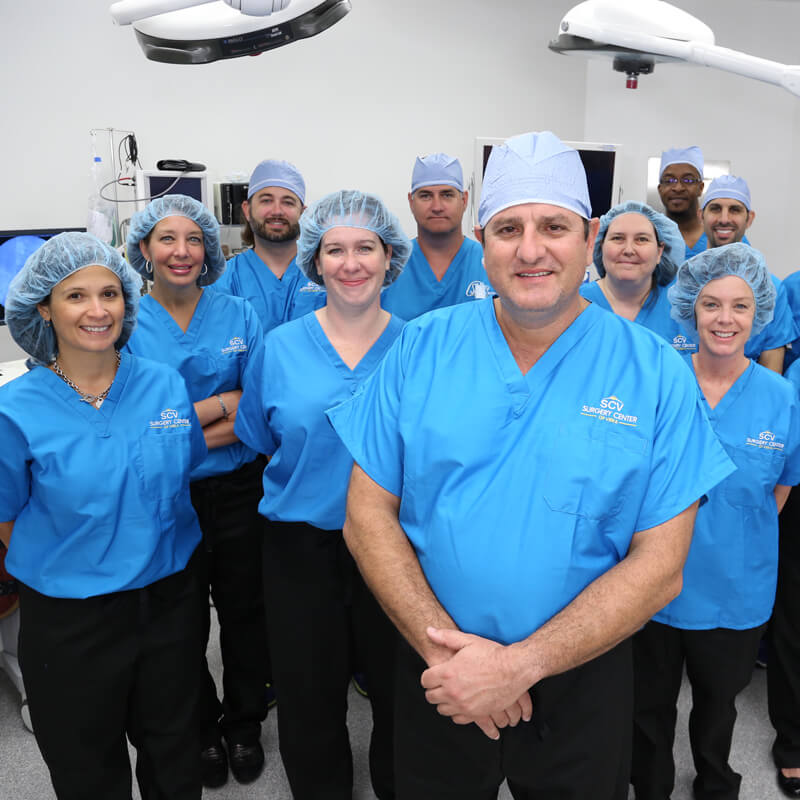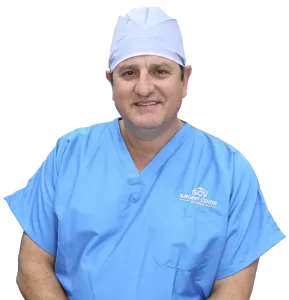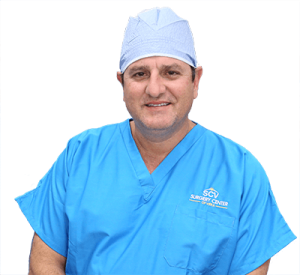A Foraminotomy, traditionally performed in a hospital setting, is normally a fairly invasive procedure that requires the repositioning of tissues and cutting of bone to alleviate pressure on the nerve. The recovery time for a traditional foraminotomy is slow and steady, with patients driving a car and performing light physical activities after 8 weeks and a full recovery within 18 months.
At Deuk Spine Institute, we have developed an advanced Foraminotomy surgery, Deuk Laser Disc Repair, for relieving pressure on nerves in the foramen that is not only minimally invasive, but requires zero bone cutting. In fact, our procedure is so effective that this is an out patient surgery and most of our patients go back to work in less than 3 days! This is a fraction of the recovery time traditional Foraminotomy patients experience.
Contact Deuk Spine Institute or call today, 1-800-FIX-MY-BACK, and learn why patients needing a foraminotomy travel from across the US to be treated by Dr. Deuk and his expert team.
Foraminotomy is a fairly-invasive, open-back surgery that is used to treat the effects of foraminal narrowing in the spine. It involves enlarging the area surrounding the compressed foramen and relieving the pressure on the pinched nerve. The spine surgeon removes bone or tissue that obstructs the foramen and causes inflammation when it compresses the spinal nerve root. To fully decompress nerves, foraminotomy is frequently combined with laminotomy and discectomy.
The vertebrae are a series of connected bones that make up the spinal column. The flat section of each vertebra is supported by intervertebral discs positioned above and below it. Altogether there are 23 intervertebral discs in the spine distributed across the cervical, thoracic and lumbar spinal segments. The primary function of the spinal column is to house and protect the spinal cord. Sensory information from the body is sent to the brain via the spinal cord. The brain also transmits signals to the body through the spinal cord. This interaction is possible due to the spinal nerves which radiate from the spinal cord, transmitting and receiving signals. These nerves exit the spinal column through a naturally-formed opening between the spinal vertebrae called the intervertebral foramen.
The neuroforamen are bony openings that run between adjacent vertebrae on either side. The size of the neuroforamen is determined by the height of the intervertebral disc separating the vertebral members. Certain factors can cause the size of a neuroforamen to reduce, such as degenerative disc disease or herniated discs, therefore leaving less room for the spinal nerve which then becomes compressed. Stiffness, numbness, and weakness experienced in different locations within the body are all possible symptoms of spinal compression.
The main condition that causes spinal compression is Foraminal stenosis. This condition develops when the neural foramen which is the opening between the spinal vertebrae begins to narrow. It is frequently caused by degenerative spine disease and can result in spinal nerve constriction and inflammation.
The narrowing of the foraminal in the spine is a common occurrence in most people beyond middle age. Spinal stenosis is most common in adults over the age of 50, however it can sometimes develop earlier in life as a result of an injury. Other potential factors that can cause spinal compression include degenerative spine diseases, bulging, slipped or herniated intervertebral discs, bone spurs (osteophytes), and spondylosis (spinal osteoarthritis).
Spinal compression symptoms and effects are usually experienced in other parts of the body because spinal nerves branch out to form the peripheral nervous system. Cervical nerve root compression, for example, might result in discomfort in the shoulders, arms, and hands. On the other hand, symptoms of lumbar nerve root compression can spread to the low back, buttocks, legs, and feet.
The main objective of spinal decompression surgery is to open up the bony channels through which the spinal nerves run so that they have more space to move freely. Decompression of the spine can be done anywhere along the cervical to the lumbar spine. The procedure is carried out through a posterior muscle incision.
Decompression surgery comes in a variety of forms:
The entire bony lamina, a portion of the enlarged facet joints, and the thicker ligaments overlying the spinal cord and nerves are removed during a laminectomy. This is a highly invasive and destructive surgery but still popular with surgeons that don’t use the latest techniques.
The removal of a smaller section of the lamina, ligaments and facet joint, usually on one side, is known as laminotomy. The natural support of the lamina on the opposite side is preserved in this procedure, reducing the risk of spinal instability. This is still a highly invasive surgery and frequently results in spinal instability due to damaging bone, ligaments and the facet joint. There are newer surgeries like Deuk Laser Disc Repair that don’t remove any bone, ligaments or facet joint and treat both pain and pinched nerves.
The removal of bone around the neural foramen – the opening via which the nerve root exits the spine – is known as a foraminotomy. When disc degeneration causes the height of the foramen to shrink and squeeze a nerve, this procedure is used. During decompression surgical procedures, surgeons often combine foraminotomy with laminotomy and discectomy to decompress nerves; however, removing bone will ultimately destabilize the spine.
The minimally invasive laser spine surgery at Deuk Spine Institute is peer-reviewed and approved as a safe disc and spine repair procedure. We are very confident in the effectiveness of our procedure as an alternative to traditional foraminotomy. We have designed it as an outpatient surgery. Most of our patients go back to their daily activities in less than three days, with little to no post-surgery pain. This is a fraction of the recovery time traditional foraminotomy patients experience.
Removing a part of a bulging or degenerative disc to relieve nerve pressure is known as a discectomy. In most cases, non-surgical treatments might be sufficient to treat the symptoms of nerve impingement due to foraminal narrowing. Some of these measures include physical therapy, pain medication, and epidural injections. However, if severe symptoms such as loss of bladder control, paralysis, and permanent loss of sensation develop, a physician might recommend a discectomy.
Although your doctor may suggest foraminotomy as a treatment option, only you can determine if surgery is best for you. Before making a decision, make sure to consider all of the risks and advantages of undergoing a foraminotomy.
Consult your surgeon about any medications, such as blood thinners, that you might need to stop consuming ahead of time. To avoid post-surgical issues, don’t eat or drink after midnight the night before your surgery.
Your doctor may schedule additional imaging tests before surgery to learn more about the state of your spinal column and nerves. An MRI is the most typical test in this scenario. The MRI scan reveals the exact location as well as the severity of spinal stenosis which causes foraminal narrowing. This information helps the surgeon to make a more educated decision about conducting your foraminotomy. Other presurgical tests such as blood tests., electrocardiograms, and chest X-rays must also be completed some days before your surgery.

Over the relevant vertebrae, a skin incision is created down the middle of the back. The incision length is determined by the number of spinal parts that need to be operated on.Once the affected vertebrae are exposed, the surgeon may remove the facet joints located above them to allow the nerve roots more room. Through this technique, the neural foramen, where the spinal nerves exit the spinal canal, is enlarged. If a herniated disc pinches the nerve roots, the surgeon will conduct a discectomy to remove the extra tissue and ligaments squeezing them. Afterward, sutures or staples are used to rejoin the muscle and skin tissue.
Nerves and the spinal cord are at risk when the spine is operated on, thus presenting the risk of complications and post-surgical infections. Numbness or even paralysis might occur as a result of nerve damage. It is likewise possible for some bone spurs to permanently injure a nerve, making decompressive surgery ineffective. At Deuk Spine, we have a low rate of complications developing post-surgery. We also have a 0% infection rate among our patients.
Patient recovery from a traditional foraminotomy can vary, but often activities like driving a car and performing light activities can be performed within eight weeks, while complete recovery should be expected in about 18 months. Patients will often experience residual pain at the site of their operation. Such pains can be managed easily with the application of prescribed oral medication. Many patients will also notice an improvement in most of the pain and weakness they experienced pre-surgery. Patients are always advised to supplement their post-surgery healing with supervised physical therapy and lifestyle modifications.
The minimally invasive laser spine surgery at Deuk Spine Institute is peer-reviewed and approved as a safe disc and spine repair procedure. We are very confident in the effectiveness of our procedure as an alternative to traditional foraminotomy. We have designed it as an outpatient surgery. Most of our patients go back to their daily activities in less than three days, with little to no post-surgery pain. This is a fraction of the recovery time traditional foraminotomy patients experience.
What is even better is Deuk Spine’s limited risk of complication. Patients will find that most other spine surgery centers have an average complication risk ranging from 5-20%. Deuk Spine patients who undergo our minimally invasive Deuk Laser Disc Repair find relief knowing that we have a less than .5% complication rate. That means for every 100 people going to another surgeon, somewhere between 5 and 20 of them experience some form of complication. At Deuk Spine, not even one person in 100 is at risk for complications. Actually, to date there have been NO complications from the Deuk Laser Disc Repair procedure and the reherniation rate is 1%.
If your Doctor or Neurosurgeon says you need a Foraminotomy, there is no better choice than Deuk Spine Institute.
Contact Deuk Spine Institute or call today, 1-800-FIX-MY-BACK and learn about our advanced foraminotomy surgery.


